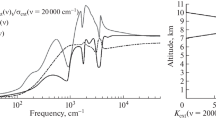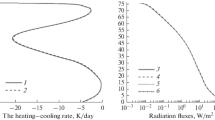Abstract
The methods for calculating the solar radiation field in the radiation block of the general circulation model of the Earth’s lower and middle atmosphere are described. These calculations use a new parametrization of molecular absorption in the frequency range from 2000 to 50 000 cm–1 in the range of heights from the Earth’s surface up to 100 km. The parametrization takes into account the change in the gas composition of the atmosphere with altitude and the violation of the local thermodynamic equilibrium in the vibrational bands of carbon dioxide with a wavelength of about 4.3 and 2.7 μm at altitudes above 70 km. The method of discrete ordinates is used for the numerical solution of the radiative transfer equation. The results of calculations performed using the radiation block of the model are compared with the results of the reference calculations of the solar radiation field in the lower and middle atmosphere of the Earth, performed with a very high frequency resolution. It is shown that the model block provides good calculation accuracy both in the absence of clouds and in the presence of cloud layers with a large optical thickness.




Similar content being viewed by others
REFERENCES
O. M. Belotserkovskii, A. M. Oparin, and V. M. Chechetkin, Turbulence: New Approaches (Nauka, Moscow, 2003; Cambridge International Science, Cambridge, 2005).
I. V. Mingalev, N. M. Astaf’eva, K. G. Orlov, V. M. Chechetkin, V. S. Mingalev, and O. V. Mingalev, “Numerical simulation of formation of cyclone vortex flows in the intratropical zone of convergence and their early detection,” Cosmic Res. 50 (3), 233–248 (2012). https://doi.org/10.1134/S0010952512020062
B. N. Chetverushkin, I. V. Mingalev, K. G. Orlov, V. M. Chechetkin, V. S. Mingalev, and O. V. Mingalev, “Gas-dynamic general circulation model of the lower and middle atmosphere of the Earth,” Math. Models Comput. Simul. 10 (2), 176–185 (2018). https://doi.org/10.1134/S2070048218020047
B. N. Chetverushkin, I. V. Mingalev, E. A. Fedotova, K. G. Orlov, V. M. Chechetkin, and V. S. Mingalev, “Calculating the natural atmospheric radiation using the general circulation model of the Earth’s lower and middle atmosphere,” Math. Models Comput. Simul. 12 (5), 803–815 (2020). https://doi.org/10.1134/S207004822005004X
Yu. M. Timofeev and A. V. Vasil’ev, Theoretical Foundations of Atmospheric Optics (Nauka, St. Petersburg, 2003) [in Russian].
K. Ya. Kondrat’ev, Actinometry (Gidrometeoizdat, Leningrad, 1965) [in Russian].
K. N. Liou, An Introduction to Atmospheric Radiation (Academic Press, New York, 1980; Gidrometeoizdat, Leningrad, 1984).
T. A. Sushkevich, Mathematical Models of Radiation Transfer (BINOM, Lab. Znanii, Moscow, 2006) [in Russian].
S. D. Tvorogov, “Application of exponential series to frequency integration of the radiative transfer equations,” Atmos. Oceanic Opt. 12 (9), 730–734 (1999).
S. D. Tvorogov and O. B. Rodimova, “Calculation of transmission functions at small pressures,” Atmos. Oceanic Opt. 21 (11), 797–803 (2008).
B. A. Fomin, “Method for parameterization of gas absorption of atmospheric radiation giv-ing the k-distribution with minimum number of terms,” Atmos. Oceanic Opt. 16 (3), 244–246 (2003).
B. Fomin and M. de Paula Corrêa, “A k-distribution technique for radiative transfer simulation in inhomogeneous atmosphere: 2. FKDM, fast k-distribution model for the shortwave,” J. Geophys. Res.: Atmos. 110 (D2), D02106 (2005). https://doi.org/10.1029/2004JD005163
J. M. Edwards and A. Slingo, “Studies with a flexible new radiation code. I: Choosing a configuration for a large-scale model,” Q. J. R. Meteorol. Soc. 122 (531), 689–719 (1996). https://doi.org/10.1002/QJ.49712253107
M.-D. Chou and M. J. Suarez, “A solar radiation parameterization for atmospheric studies,” NASA/TM-1999-104606, in Technical Report Series on Global Modeling and Data Assimilation, Vol. 15 (NASA Goddard Space Flight Center, Greenbelt, MD, 1999). https://ntrs.nasa.gov/citations/19990060930
S. Cusack, J. M. Edwards, and J. M. Crowther, “Investigating k distribution methods for parametrizing gaseous absorption in the Hadley Centre Climate Model,” J. Geophys. Res.: Atmos. 104 (D2), 2051–2057 (1999). https://doi.org/10.1029/1998JD200063
T. Nakajima, M. Tsukamoto, Y. Tsushima, A. Numaguti, and T. Kimura, “Modeling of the radiation process in an atmospheric general circulation model,” Appl. Opt. 39 (27), 4869–4878 (2000). https://doi.org/10.1364/AO.39.004869
R. J. Hogan, “The full-spectrum correlated-k method for longwave atmospheric radiative transfer using an effective Planck function,” J. Atmos. Sci. 67 (6), 2086–2100 (2010). https://doi.org/10.1175/2010JAS3202.1
B. N. Chetverushkin, Mathematical Modeling of Problems of Radiating Gas Dynamics (Nauka, Moscow, 1985) [in Russian].
V. Ya. Gol’din and B. N. Chetverushkin, “Methods of solving one-dimensional problems of radiation gas dynamics,” USSR Comput. Math. Math. Phys. 12 (4), 177–189 (1972). https://doi.org/10.1016/0041-5553(72)90122-X
A. V. Shilkov and M. N. Gerthev, “Verification of the Lebesgue averaging method,” Math. Models Comput. Simul. 8 (2), 93–107 (2016). https://doi.org/10.1134/S2070048216020125
E. N. Aristova, M. N. Gertsev, and A. V. Shilkov, “Lebesgue averaging method in serial computations of atmospheric radiation,” Comput. Math. Math. Phys. 57 (6), 1022–1035 (2017). https://doi.org/10.1134/S0965542517060045
I. V. Mingalev, E. A. Fedotova, and K. G. Orlov, “Parameterization of the infrared molecular absorption in the Earth’s lower and middle atmosphere,” Atmos. Oceanic Opt. 31 (6), 582–589 (2018). https://doi.org/10.1134/S102485601901010X
M. López-Puertas and F. W. Taylor, Non-LTE Radiative Transfer in the Atmosphere, in Series on Atmospheric, Oceanic and Planetary Physics, Vol. 3 (World Scientific, Singapore, 2001). https://doi.org/10.1142/4650
G. M. Shved, Introduction to the Dynamics and Energetics of the Atmosphere (Izd. S.-Peterb. Gos. Univ., St. P-etersburg, 2020) [in Russian].
G. M. Shved and A. O. Semenov, “The standard problem of nonlocal thermodynamic equilibrium radiative transfer in the rovibrational band of the planetary atmosphere,” Solar Syst. Res. 35 (3), 212–226 (2001). https://doi.org/10.1023/A:1010478906172
M. López-Puertas, R. Rodrigo, A. Molina, and F. W. Taylor, “A non-LTE radiative transfer model for infrared bands in the middle atmosphere. I. Theoretical basis and application to CO2 15 μm bands,” J. Atmos. Terr. Phys. 48 (8), 729–748 (1986). https://doi.org/10.1016/0021-9169(86)90022-X
M. López-Puertas, R. Rodrigo, J. J. López-Moreno, and F. W. Taylor, “A non-LTE radiative transfer model for infrared bands in the middle atmosphere. II. CO2 (2.7 and 4.3 μm) and water vapour (6.3 μm) bands and N2(1) and O2(1) vibrational levels,” J. Atmos. Terr. Phys. 48 (8), 749–764 (1986). https://doi.org/10.1016/0021-9169(86)90023-1
M. López-Puertas, G. Zaragoza, M. Á. López-Valverde, and F. W. Taylor, “Non local thermodynamic equilibrium (LTE) atmospheric limb emission at 4.6 μm: I. An update of the CO2 non-LTE radiative transfer model,” J. Geoph. Res.: Atmos. 103 (D7), 8499– 8513 (1998). https://doi.org/10.1029/98JD00209
V. P. Ogibalov, V. I. Fomichev, and A. A. Kutepov, “Radiative heating effected by infrared CO2 bands in the middle and upper atmosphere,” Izv.—Atmos. Oceanic Phys. 36 (4), 454−464 (2000).
H. Nebel, P. P. Wintersteiner, R. H. Picard, J. R. Winick, and R. D. Sharma, “CO2 non-local thermodynamic equilibrium radiative excitation and infrared dayglow at 4.3 μm: Application to Spectral Infrared Rocket Experiment data,” J. Geophys. Res.: Atmos. 99 (D5), 10409–10419 (1994). https://doi.org/10.1029/94JD00315
V. P. Ogibalov, A. A. Kutepov, and G. M. Shved, “Non-local thermodynamic equilibrium in CO2 in the middle atmosphere: II. Populations of the ν1 ν2 mode manifold states,” J. Atmos. Solar-Terr. Phys. 60 (3), 315–329 (1998). https://doi.org/10.1016/S1364-6826(97)00077-1
V. P. Ogibalov, “The CO2 non-LTE problem taking account of the multiquantum transitions on the ν2-mode during CO2−O collisions,” Phys. Chem. Earth, Part B 25 (5–6), 493–499 (2000). https://doi.org/10.1016/S1464-1909(00)00051-4
V. P. Ogibalov and G. M. Shved, “Non-local thermodynamic equilibrium in CO2 in the middle atmosphere: III. Simplified models for the set of vibrational states,” J. Atmos. Solar-Terr. Phys. 64 (4), 389–396 (2002). https://doi.org/10.1016/S1364-6826(01)00113-4
I. V. Mingalev, K. G. Orlov, and E. A. Fedotova, “Allowing for local thermodynamic non-equilibrium in the vibrational bands of carbon dioxide molecules in the radiation block of the model of the general circulation of Earth’s atmosphere,” Bull. Russ. Acad. Sci.: Phys. 85 (3), 282–286 (2021). https://doi.org/10.3103/S1062873821030175
L. S. Rothman, I. E. Gordon, Y. Babikov, et al., “The HITRAN2012 molecular spectroscopic database,” J. Quant. Spectrosc. Radiat. Transfer 130, 4–50 (2013). https://doi.org/10.1016/j.jqsrt.2013.07.002
E. J. Mlawer, V. H. Payne, J.-L. Moncet, et al., “Development and recent evaluation of the MT_CKD model of continuum absorption,” Philos. Trans. R. Soc., A 370 (1968), 2520–2556 (2012). https://doi.org/10.1098/rsta.2011.0295
N. I. Ignat’ev, I. V. Mingalev, A. V. Rodin, and E. A. Fedotova, “A new version of the discrete ordinate method for the calculation of the intrinsic radiation in horizontally homogeneous atmospheres,” Comput. Math. Math. Phys. 55 (10), 1713–1726 (2015). https://doi.org/10.1134/S0965542515100103
I. V. Mingalev, E. A. Fedotova, and K. G. Orlov, “The effect of optically thick cloud layers on heating of the atmosphere self emission at mid-latitudes,” Sovrem. Probl. Distantsionnogo Zondirovaniya Zemli Kosmosa 14 (5), 100–108 (2017). https://doi.org/10.21046/2070-7401-2017-14-5-259-267
R. A. McClatchey, H.-J. Bolle, K. Ya. Kondratyev, et al., “A preliminary cloudless standard atmosphere for r-adiation computation,” Report WCP–112, WMO/TD-No. 24, World Climate Research Programme, Int. A-ssociation for Meteorology and Atmospheric Physics, Radiation Commission (Boulder, CO, USA, 1986).
V. A. Gasilov, P. A. Kuchugov, O. G. Olkhovskaya, and B. N. Chetverushkin, “Solution of the self-adjoint r-adiative transfer equation on hybrid computer systems,” Comput. Math. Math. Phys. 56 (6), 987–995 (2016). https://doi.org/10.1134/S0965542516060130
Author information
Authors and Affiliations
Corresponding author
Ethics declarations
The authors declare that they have no conflicts of interest.
Rights and permissions
About this article
Cite this article
Chetverushkin, B.N., Mingalev, I.V., Fedotova, E.A. et al. Calculation Block of the Solar Radiation Field in the General Circulation Model of the Lower and Middle Atmosphere of the Earth. Math Models Comput Simul 14, 783–798 (2022). https://doi.org/10.1134/S2070048222050040
Received:
Revised:
Accepted:
Published:
Issue Date:
DOI: https://doi.org/10.1134/S2070048222050040




